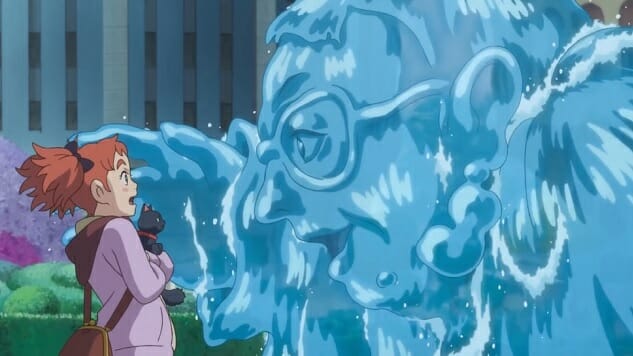Mary and the Witch’s Flower

There’s something heartbreaking to the idea of a child who’s eager to help around the house but creates more of a mess than they end up cleaning. That’s Mary, the title character of Hiromasa Yonebayashi’s new film Mary and the Witch’s Flower, released in Japan last July and now running in U.S. theaters. She wants to be useful to her great-aunt Charlotte (Lynda Baron), and to Charlotte’s housekeeper, Miss Banks (Morwenna Banks), but she can’t relieve Charlotte of an empty teacup without dropping it on the floor. She can’t lend a hand to the gardener, Zebedee (Rasmus Hardiker), without accidentally killing one of his plants. She can hardly set foot outside without getting caught in a bucket of dead leaves. The kid’s a walking disaster. It’s practically tragic.
Mary, voiced by the winsome Ruby Barnhill (The BFG) in the film’s English dub, putters around Charlotte’s home in part out of love for her great-aunt, in part for want of anything better to do. Yonebayashi sets Mary and the Witch’s Flower in the English countryside during the summer, when all the other kids are away and Mary is left bored out of her gourd. She’s a good kid, she just has nothing to do, until she meets a couple of outdoor cats who lead her to a clutch of glowing blue flowers which capture her curiosity on sight. Not knowing exactly what they are (hint: they’re witch’s flowers), Mary takes them back to Charlotte’s and quickly discovers that the flowers bestow temporary magical abilities on whoever touches them.
Mary and the Witch’s Flower’s plot—and, boy, there’s a lot of plot—kicks off from there: Mary is whisked away by a flying sentient broom to an academy for witches, led by Madame Mumblechook (Kate Winslet) and Doctor Dee (Jim Broadbent), who put on a kindly front that disguises unsavory intentions. (Turns out that the flowers’ powers make them a hot commodity for anyone interested in scientific experimentation.) There’s a familiarity to Mary and the Witch’s Flower as narrative: Harry Potter-lite by way of Studio Ghibli-lite with a dash of Yonebayashi’s past thematic interests. It isn’t a Ghibli film, of course, being the first feature by Studio Ponoc, but it’s hard to separate Yonebayashi’s time working with Ghibli from Mary and the Witch’s Flower (just as it’s hard to separate Ghibli’s influence on Japanese animation from Japanese animation as a non-monolithic aesthetic).
Like his second film, When Marnie Was There, Mary and the Witch’s Flower is about a girl lacking identity who ends up on a quest that leads her to it. Like Harry Potter, that identity is wrapped up in a heretofore unknown affinity for sorcery. Like a majority of Ghibli films, the whole thing is spirited, gentle and unfailingly lovely. You’ll know whether or not that summary appeals to you the minute you’ve scoped out the movie’s credentials, but there’s literally something in here for everyone. Who doesn’t like a good-natured Ghibli lookalike? Who doesn’t enjoy Harry Potter? Who isn’t fond of magic in all of its forms, whether it be the magic of hand-drawn animation or actual spellcraft?
-

-

-

-

-

-

-

-

-

-

-

-

-

-

-

-

-

-

-

-

-

-

-

-

-

-

-

-

-

-

-

-

-

-

-

-

-

-

-

-








































